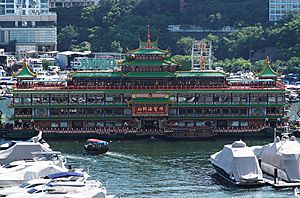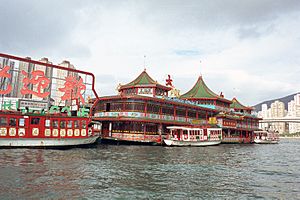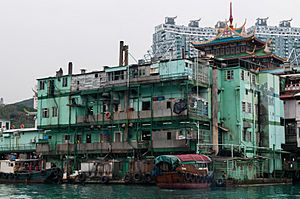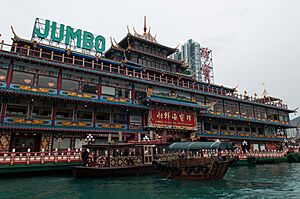Jumbo Kingdom facts for kids
Quick facts for kids Jumbo Kingdom |
|
|---|---|
 |
|

Jumbo Kingdom in 2017
|
|
| Restaurant information | |
| Established | 19 October 1976 |
| Closed | 3 March 2020 (Jumbo Floating Restaurant capsized on 19 June 2022 after leaving Hong Kong) |
| Current owner(s) | Stanley Ho |
| Food type | Cantonese, dim sum, Western |
| Street address | Shum Wan Pier Drive, Wong Chuk Hang, Aberdeen, Hong Kong |
| City | Hong Kong |
| Coordinates | 22°14′35.5″N 114°9′43.2″E / 22.243194°N 114.162000°E |
| Seating capacity | 2300 |
| Jumbo Kingdom | |||||||||
|---|---|---|---|---|---|---|---|---|---|
| Traditional Chinese | 珍寶王國 | ||||||||
| Literal meaning | Treasure Kingdom | ||||||||
|
|||||||||
| Jumbo Floating Restaurant | |||||||||
| Traditional Chinese | 珍寶海鮮舫 | ||||||||
|
|||||||||
| Tai Pak Floating Restaurant | |||||||||
| Traditional Chinese | 太白海鮮舫 | ||||||||
|
|||||||||
Jumbo Kingdom (Chinese: 珍寶王國) was a famous floating restaurant complex in Hong Kong. It included the Jumbo Floating Restaurant and the Tai Pak Floating Restaurant. These restaurants were big tourist spots in the Aberdeen Harbour.
For 44 years, over 30 million people visited Jumbo Kingdom. Famous guests included Queen Elizabeth II and movie stars like Tom Cruise. A smaller version, Jumbo Kingdom Manila, also operated in the Philippines for eight years.
Jumbo Kingdom stopped working in 2020 because of the COVID-19 pandemic. On June 14, 2022, the Jumbo Floating Restaurant was towed away from Hong Kong. It was heading to Cambodia for a new owner. However, it met bad weather in the South China Sea and capsized (turned over) on June 19, 2022. Its owners said it had capsized, not completely sunk.
How Floating Restaurants Started
Long ago, in places like Guangzhou, fishermen used their boats for parties. They built stages on them for banquets, singing, and dancing. In the 1920s and 1930s, Hong Kong fishermen in Aberdeen started doing the same.
At first, these floating restaurants only served other fishermen. But soon, they became popular with everyone. People loved eating fresh seafood on the water.
Jumbo Kingdom's Story
The Jumbo Kingdom was built by Stanley Ho and opened in October 1976. It cost over HK$30 million to design and build. The restaurant looked like an old Chinese imperial palace, with beautiful decorations.
Later, Stanley Ho bought two other floating restaurants, Tai Pak in 1980 and Sea Palace in 1982. He then ran all three under the Jumbo Kingdom name.
Tai Pak Floating Restaurant
The Tai Pak Floating Restaurant started in 1952. Four investors bought a boat and turned it into a restaurant. It was about 32 meters long. Six years later, Tai Pak was made bigger to hold 800 guests.
Tai Pak was smaller than Jumbo. In 2022, there were talks about renovating it. The new owners planned to offer a mix of Asian and Western food. They also wanted to help promote Hong Kong tourism. However, these plans have been put on hold because of ongoing legal issues.
Jumbo Floating Restaurant
The Jumbo Floating Restaurant was built by Wong Lo-kat. It cost HK$14 million and also looked like an imperial palace. Sadly, before it even opened, a serious fire happened on October 30, 1971. It had to be rebuilt by new owners Stanley Ho and Cheng Yu-ting. After spending HK$30 million in total, the restaurant finally opened in 1976.
In the 1980s and 1990s, Jumbo was a very popular place. Many investors and tourists visited it. People enjoyed delicious food like crabs, lobster, and roasted pig. Even though locals knew other places had great food, Jumbo's unique look made it a symbol of Hong Kong.
The restaurant was even featured in the 1996 comedy film The God of Cookery. A cooking competition in the movie took place inside Jumbo.
Jumbo Floating Restaurant closed for a while after the 1997 Asian financial crisis. In 2003, it had a big makeover that cost millions of dollars. It became 76 meters long and could seat 2,300 diners. It even had a dragon throne and a six-story pagoda.
On March 1, 2020, the restaurant announced it would close. This was due to the COVID-19 pandemic, and all staff were laid off.
There were ideas to save the restaurant, like moving it to land. Some even suggested turning it into a Bruce Lee museum. But all these ideas faced problems. The main issue was the very high cost of keeping it running. No one wanted to pay the millions of Hong Kong dollars needed each year.
Jumbo Capsizes in 2022
The Jumbo Floating Restaurant had been losing money since 2013. By 2022, it had lost over HK$100 million. On May 30, 2022, the owners said Jumbo would leave Hong Kong in June. They had tried to donate it, but no one wanted it due to the high costs.
On May 31, the kitchen boat of the restaurant started to tilt. This happened while getting ready to tow the main restaurant. The Jumbo restaurant barge was towed out of Hong Kong on June 14. Its destination was Cambodia.
On June 18, 2022, while being towed in the South China Sea, Jumbo faced bad weather. It started to tilt more and more. Despite efforts to save it, the restaurant fully capsized the next day. This happened near the Paracel Islands in very deep water. The owners stated it had capsized, not completely sunk.
Many people in Hong Kong were sad to see Jumbo go. A student named Shiu Ka-heng created a digital 3D model of Jumbo. He used photos to make a virtual model that people can see with virtual reality goggles. This helps to remember important parts of Hong Kong's history.
Sea Palace
In 1991, Sea Palace was renamed "Jumbo Palace." After the 1997 Asian financial crisis, it was sold for US$8 million. It was then towed to Manila Bay in the Philippines. There, it became "Jumbo Kingdom Manila." It kept its old Chinese palace style. This restaurant closed in 2008.
In 2011, the boat was given to the government of Shandong province in China. It was towed to Tsingtao to be part of a new seaside park. The plan was to rebuild it and reopen it for events like weddings. However, the renovations were still not finished by 2021.
Fun Things at Jumbo Kingdom
- Roof Deck: This was an outdoor dining area on the top deck. It served fancy Western food.
- Dragon Court: A beautiful Chinese restaurant on the first deck of Jumbo. Its design mixed old Chinese styles with new ones.
- Shum Wan Pier Garden: An outdoor space used for weddings and parties.
Jumbo Kingdom also had a staff canteen called So-Kee Coffee Shop. It served popular Hong Kong cuisine like noodles. There was also a cooking school and rooms for meetings and banquets.
You could get to the restaurants by a free shuttle boat. These boats left from Aberdeen Promenade or Sham Wan pier.
Images for kids
See also
- Floating restaurant
- List of restaurants in China








